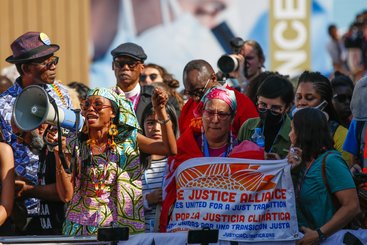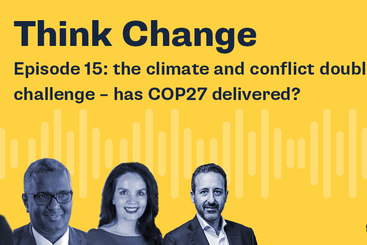The COP27 decision to set up a loss and damage fund represents one of the most significant breakthroughs in the climate negotiations over the past 30 years. It was also, in some ways, the easy part. The ‘Transitional Committee’, which is now being established, has its work cut out for it on how to operationalise the fund.
The Committee will need to address six key political and technical questions regarding the structure, purpose and operations of the fund over the coming year:
1. What constitutes ‘loss and damage’?
One of the pressing questions for the Transitional Committee is to clearly define the meaning and scope of loss and damage. Although Article 8 of the Paris Agreement highlights the importance of “averting, minimising and addressing loss and damage”, there is no official or precise definition of what constitutes climate-induced loss and damage, or what addressing it means.
Some consensus is emerging among policy analysts and researchers that loss and damage should refer to those impacts deemed ‘beyond adaptation’ - that is, which have not been or cannot be avoided. Loss and damage finance should focus on addressing such impacts and assisting people who are already suffering the effects of climate change (rather than averting or minimising these impacts, which can be done using existing climate finance).
However, even addressing loss and damage will likely involve pre-event actions: for example, proactive measures to assess risks and anticipate impacts, and to establish and maintain contingency funds or insurance mechanisms. Consideration will need to be given to the overlaps between anticipatory actions and responses, as well as between existing humanitarian assistance and disaster risk financing mechanisms, to identify gaps and avoid duplication of efforts.
Greater clarity will also be needed on the distinction between 'economic’ and ‘non-economic’ losses. Economic losses – like damage to property or crops losses – are more easily quantifiable and therefore easier to target with financial assistance. Non-economic losses, such as the loss of cultural heritage, territory, and climate migration or displacement, are much more difficult to estimate. But this doesn’t mean that easily quantifiable, and seemingly larger, direct economic damages should necessarily be prioritised.
Finally, the Committee must decide whether and how the fund should address the compound impacts of climate change, in which slow-onset processes, like temperature increase and sea-level rise, produce fast-onset events, like heat waves and storm surge.
2. How much loss and damage finance is needed?
With an unclear definition and lack of systematic framing for loss and damage, it is extremely difficult to have a robust estimate for the costs of addressing these impacts, let alone minimising or averting them. A starting point would be to devise a standard framework for tracking climate-related loss and damage. This could build on data collected by EM-DAT, and reporting undertaken through the Sendai Framework Monitor on direct economic damages, with additional work to assess non-economic losses. Once a standard framework for loss and damage is developed, an analysis of available budgetary and non-budgetary financial resources for eligible countries would be required to estimate the loss and damage funding gap.
Without a standard framework, it will be difficult to assess gaps in loss and damage funding. Existing mechanisms of national, bilateral, multilateral and private sector finance could already include funding for addressing loss and damage, but this may be referred to as ‘humanitarian aid’, ‘disaster risk management’ or ‘adaptation’ activities. Any cost estimation for loss and damage will always be subject to uncertainties and several assumptions, but without one, estimates of financial needs are meaningless.
3. Who will get the funding?
The Transitional Committee will need to decide whether loss and damage funding should be directed at vulnerable countries - i.e. national or subnational governments - and/or vulnerable communities, with international and local NGOs and civil society organisations as intermediaries.
If developing country governments are to decide how loss and damage finance is spent, then, given the (likely) limited availability of funding, the most vulnerable countries should be prioritised. But which are the most vulnerable? Not necessarily the poorest countries. Many small island developing states are (upper) middle- and high-income countries but are arguably the most vulnerable in terms of income loss from extreme weather, as well as loss of territory due to sea level rise, and have high levels of debt and limited resources to withstand the impacts.
The Committee should consider a uniform and transparent fund allocation approach, similar to that typically used by multilateral development banks and funds, such as the World Bank’s IDA allocation criteria and the Global Environment Facility’s STAR criteria. As these funds do, the loss and damage fund could use a combination of ‘needs-based’ criteria (such as a country’s economic and financial limitations and vulnerability to climate change) and ‘performance-based’ criteria (its ability and performance in utilising the allocated money) to assign funds.
Moreover, if the Transitional Committee decides the fund should earmark funding for particular communities or types of impacts, it will still have to devise a clear and transparent fund allocation framework.
4. How will the funds be delivered?
Once eligibility and allocation criteria for loss and damage finance are decided, the committee will have to consider how the funds will be delivered to recipients. The committee must decide whether allocated funds can go through existing regional, national, or local budgetary arrangements for governments to allocate as they see fit, or whether specific loss and damage funds need to be set up.
The People's Survival Fund in the Philippines is one example where supplementary funding for adaptation activities is provided through a dedicated fund to local governments and accredited civil society organisations.
5. How will the funds be mobilised?
The question of ‘who will pay for loss and damage?’ is one of the most contentious issues in the international climate change negotiations. Developed countries have deep concerns that loss and damage could become a matter for compensation and liability. Indeed, their acquiescence to the development of a loss and damage fund was contingent on there being no mention of these terms in the outcome text of the COP27 negotiations.
Loss and damage finance contributions to date from several sovereign and non-sovereign states have been made in a ‘spirit of solidarity’ with those vulnerable developing countries facing grave and existential threats from climate change. But responsibility should rest not only with governments but, according to UN Secretary General Antonio Guterres, should extend to the fossil fuel industry through a ‘loss and damage tax’ levy, which would be collected and contributed to the fund by the countries in which they are operating.
Given the voluntary nature of loss and damage finance, the Transitional Committee and all Parties to the Paris Agreement will have to agree on a way to raise contributions to the fund going forward. This should not be confined to the first tranche of voluntary contributions from rich nations, but rather a more sustainable mechanism to replenish the fund regularly.
6. How will the fund be managed?
The Committee will have to decide whether the loss and damage fund will be linked to an existing fund under the UNFCCC, or whether a new standalone fund is needed. The challenge here will be to clearly emphasise how it is different from, or complements, existing funding mechanisms.
The true success of a loss and damage fund will depend on its ability to effectively deliver finance to support those most severely affected by the adverse effects of climate change. A lot of work needs to be done over the coming year to clarify concepts, understand needs, establish principles, and ensure that after years of hard work, advocates’ ambitious hopes for loss and damage finance come to fruition.




